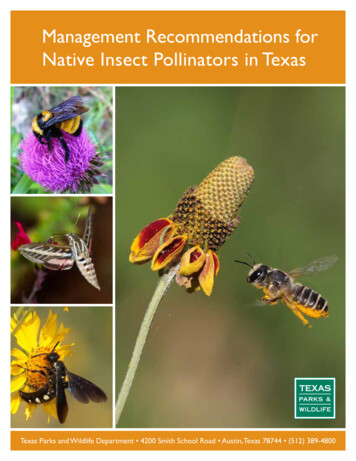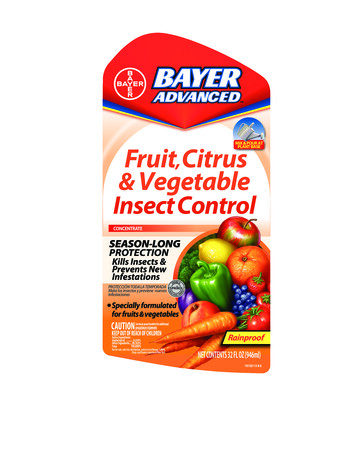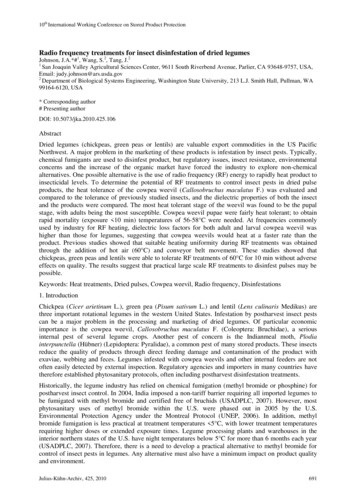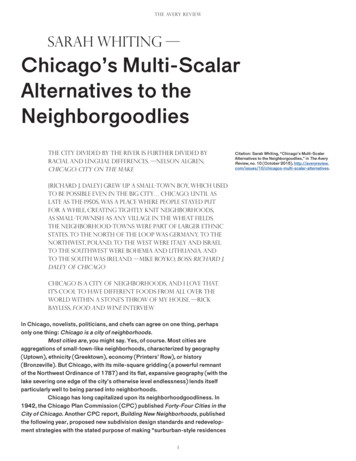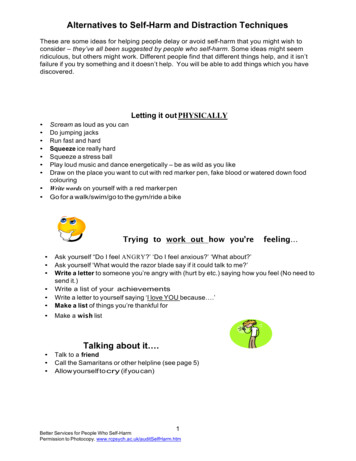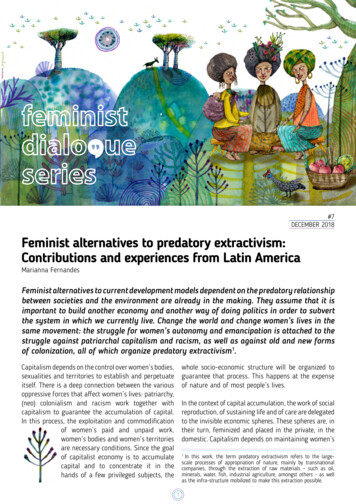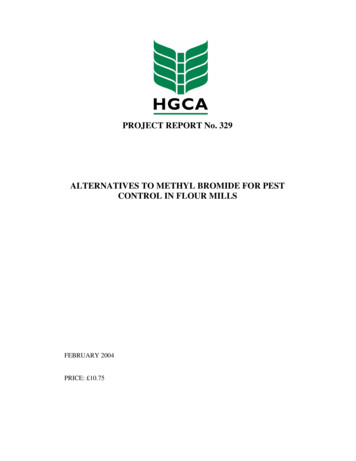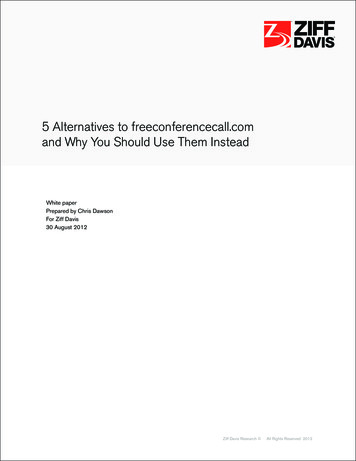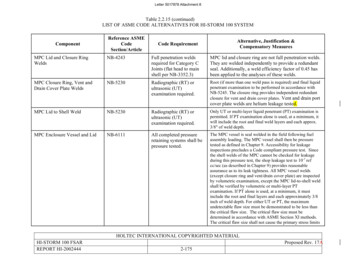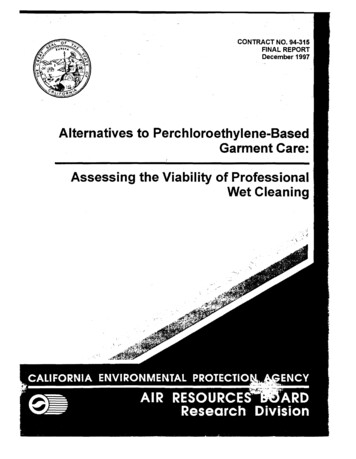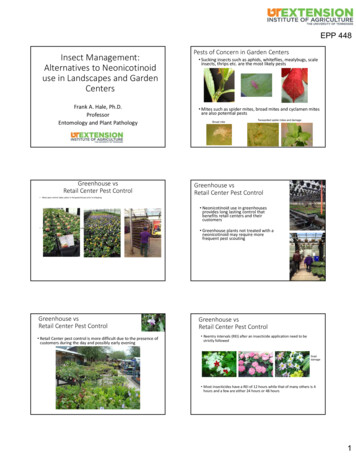
Transcription
EPP 448Insect Management:Alternatives to Neonicotinoiduse in Landscapes and GardenCentersFrank A. Hale, Ph.D.ProfessorEntomology and Plant PathologyGreenhouse vsRetail Center Pest Control Most pest control takes place in the greenhouse prior to shippingPests of Concern in Garden Centers Sucking insects such as aphids, whiteflies, mealybugs, scaleinsects, thrips etc. are the most likely pests Mites such as spider mites, broad mites and cyclamen mitesare also potential pestsBroad miteTwospotted spider mites and damageGreenhouse vsRetail Center Pest Control Neonicotinoid use in greenhousesprovides long lasting control thatbenefits retail centers and theircustomers Retail centers should only accept pest free plants from suppliersGreenhouse vsRetail Center Pest Control Retail Center pest control is more difficult due to the presence ofcustomers during the day and possibly early evening Greenhouse plants not treated with aneonicotinoid may require morefrequent pest scoutingGreenhouse vsRetail Center Pest Control Reentry intervals (REI) after an insecticide application need to bestrictly followedSnaildamage Most insecticides have a REI of 12 hours while that of many others is 4hours and a few are either 24 hours or 48 hours1
EPP 448An Ornamental Plant Pest ManagementGuide and Pesticide Rotation Planning Aid Control options for nursery, greenhouse, interiorscape, andcommercial landscape use sites An online publication from UT Extension, UT AgResearch andClemson University ents/W329.pdfUsing the GuideUsing the Guide The “x” in the pest column means that theinsecticide is labeled for that pest Neonicotinoid insecticides are listed at the top ofthe second page of the chart (IRAC [mode of action]code 4A) There are many chemical alternatives forneonicotinoidsXXpire For example, non‐neonicotinoid insecticides for aphids inthe landscape are plentiful Some select listed aphid insecticides are: XXpire (IRACCode 4C 5) ‐ can only use existing stocks Orthene T&O, Lepitect, Inject‐A‐Cide B, Malathion 5E,Malathion 8F, Harpoon (1B) Onyx, Onyx Pro, Menace GC, Decathlon, Tempo Ultra WP,Tempo SC Ultra, Scimitar CS, Scimitar GC, Demon WP,Mavrik Aquaflow, Astro, Permethrin Pro, Perm‐Up 3.2 ECUsing the GuideCannaleafroller Active ingredients are sulfoxaflor spinetoram (IRAC4C 5) Since the EPA cancellation order on Nov. 12, 2015 forsulfoxaflor containing products, growers can only usetheir existing stocks of these products For use in landscape, nursery and greenhouse More non‐neonicotinoid insecticides labeled for aphidsin the landscape Avid, Lucid, Aracinate TM, Arbormectin (6) Sirocco (6 unknown mode of action) Prev‐AM Ultra (8D) Endeavor (9B) Aria (9C)2
EPP 448SiroccoEndeavor Active ingredients are abamectin bifenazate Active ingredient is pymetrozine For use on landscape, nursery, greenhouse andinteriorscape For use in landscape, nursery, greenhouse andinteriorscape Listed pests include: aphids, whiteflies, thrips, leafminer(fly), broad mite, eriophyid mites, spider mites Listed pests include: aphids and whitefliesEriophyid (rust) mitesBroad mite damageImage courtesy ofA. Windham, UTAriaUsing the Guide Active ingredient is flonicamid For use in landscape, nursery and greenhouseCottony cushion scale ovisacsand crawlers on Nandina More non‐neonicotinoid insecticides labeled for aphidsin the landscape Distance IGR and Fulcrum (7C) Listed pests include: aphids, armored scales, soft scales,mealybugs, whiteflies, thrips, leafhoppers, and plant bugs Acelepryn (28) Azatin O and others (Unknown mode of action) BotaniGard ES, BotaniGard 22 WP, Naturalis‐L, GrandevoPTO, NoFly, Preferal, Ultra‐Pure Oil, M‐Pede, Trilogy,Triact 70 (not classified mode of action)Distance IGR and Fulcrum Active ingredient is pyriproxifen For use in landscape, nursery, greenhouse, andinteriorscape Listed pests include: aphids, armored scales, soft scales,mealybugs, whiteflies, thrips, leafminers (moth), fungusgnats, and shore fliesAlternatives to Neonicotinoids forInsect Control in the LandscapeVariousarmoredscale3
EPP 448Wood‐boring Insects are Important Pests Especially of stressed trees andshrubs which they often attack Wood borers have the potential tocause severe damage or even deathof plantsWood‐boring Insect Control UsingNeonicotinoids Soil or media applied systemic neonicotinoids appliedpreventatively have enabled landscape professionalsand growers of container grown plants to bettercontrol flatheaded borers and roundheaded borersFlatheaded appletree borer Damage is often cumulative as theplant can become infested yearafter yearAlternative Borer Control Using Bark SpraysPeachtree Borer (A Clearwing Borer) Bark applied contact insecticides should be appliedjust prior to egg laying (flatheaded borers,roundheaded borers, clearwing borers,carpenterworms, American plum borer, root collarborer, bark beetles, ambrosia beetles, variousweevils & others) Note that more than one application is needed formany of the wood‐boring pests Lesser Peachtree Borer MothPeachtree Borer Attacks fruit bearing or ornamental cherry, plum, peach andother Prunus spp.trees and shrubs, including cherrylaurelBanded AshClearwing Spray any exposed roots, the trunk and lower limb scaffoldof ornamental Prunus spp. in late May and in mid‐July4
EPP 448Rhododendron BorerOak Clearwing Moth Borer Attacks rhododendron and occasionally mountain‐laureland deciduous azalea Apply protective sprays inmid‐May and late JuneImage of empty pupal case courtesy of Brett A. Hubbard, Woodland Tree Services, LLCClearwing Borer Bark Spray Timing forTennessee An oak borer (early June & July 1) Ash borer (lilac, fringetree, mountain‐ash, privet in mid‐April& mid‐June) Ash borer and banded ash clearwing (ash trees in mid‐Apriland mid‐July) ‐ Note that banded ash clearwing may require athird spray in early September during cool summersClearwing borer bark sprays in the landscape Protective sprays of bifenthrin (Onyx, Onyx Pro),permethrin (Astro, Perm‐Up), or chlorantraniliprole(Acelepryn) can be applied to the bark Application timing is important and a repeat applicationmay be needed if the egg laying period is extended Dogwood borer (late April, mid‐July and early September) Rhododendron borer (mid‐May and late June) Peachtree borer (late May and mid‐July)RhododendronborerBanded ash clearwing imagecourtesy of A. WindhamDamagedash treeFlatheaded Appletree Borer Attacks some 30 species of woody plants, but maple, hickory, linden,oak, sycamore, tuliptree, dogwood, and apple are most commonlyinfested Apply protective pyrethroid sprays inmid‐May and late June (TN timing)5
EPP 448D‐Shaped Exit Holes First found in southeastern Michigan and Windsor, Ontario,Canada in 2002, but thought to have been established there for 6‐10 years prior to that date Now found throughout Michigan, across much of Ohio, and inparts of Indiana, Illinois, Maryland, Missouri, Minnesota, NewYork, Kentucky, Pennsylvania, Virginia, West Virginia, Wisconsin,Iowa, and East Tennessee (2010). Also, infestations found in moreareas of Ontario and in Quebec.Emerald Ash Borer LarvaeBlonding byWoodpeckers6
EPP 448Partial list of available insecticide options http://www.emeraldashborer.info/files/multistate EAB Insecticide Fact Sheet.pdfPartial list of available insecticide state EAB Insecticide Fact Sheet.pdfGranulateAmbrosiaBeetle (GAB)Attacks trees in late winter to early springDecision Guide for Applying Spray Treatments AgainstAmbrosia Beetles Ethyl alcohol baited traps are used todetect the late winter or early spring flightImage by M. WindhamAmbrosia Beetle “Baker” Trap note122/note122.html The need to use an insecticide spray isgreater if the beetles have been caught inthe traps and the trees have not brokendormancy7
EPP 448Granulate Ambrosia Beetle ControlScale Control Without Neonicotinoids Best to treat with bifenthrin or permethrin preventatively Or treat at first sign of attack (mid‐March to May) The key to scale control is to apply an insecticidewith thorough coverage when the crawlers haveemerged from the eggs Thus, monitoring for crawlers is essential todetermine the proper timing of the insecticidespraysScale MonitoringEuonymus Scale Settled Crawlers Sticky traps can be made to catch the emerging scalecrawlers Use double sided Scotch tape, black electrical tape, oreven white tape coated with a thin layer of petroleumjelly (Tape color depends on crawler color) Flag the branch and check at least once per week starting10‐14 days before expected emergenceScale Insecticides A dormant application of horticultural oil Target crawlers with horticultural oil,malathion, Sevin, Carbaryl, Orthene,Insecticidal soap, Distance, Fulcrum, andTalus 70 DFInsect Growth Regulator Insecticides Insect growth regulators (IGRs) such aspyriproxyfen (Distance, Fulcrum) and buprofezin(Talus 70 DF) target crawlers IGRs have been very effective on many species ofimmature scale8
EPP 448Crape Myrtle Bark ScaleEriococcus lagerostroemiaImages courtesy of M. Merchant, Texas A&M AgriLife ExtensionCrape Myrtle Bark ScaleAdult FemaleNew fact sheets at:http://www.uaex.edu/Other Areas/publications/pdf/fsa‐7086.pdfAnd �049.htmImage courtesy of M. Merchant, Texas A&M AgriLife ExtensionCrape Myrtle Bark Scale Populations ‐ USACrape Myrtle Bark Scale EggsGermantown, TN (2013)Collierville, TN (2014)Ardmore, OK(2012)Little Rock, AR(2014)Newnan, GA(2013)RichardsonShreveportMonroeMcKinney Longview Bossier City(2014)TylerPlano(2011)(2011, 2012)DallasMinden(2004, 2005,Alexandria2006, 2007)(2014)CollegeStation(2013)Houma(2012)In 2014, CMBS was also detected in Mobile, AL; Fayette County, TN; and BernalilloCounty, New Mexico. In March 2015, CMBS was found in south Mississippi.9
EPP 448Crape Myrtle Bark Scale Controlin the Landscape As needed, use a JD9‐C spray gun at 125 – 150 psiwith dishwashing soap or insecticidal soap solutionas a pressure wash to physically remove scaleCrape Myrtle Bark Scale Controlin the Landscape Target crawlers with insecticide sprays when they emergearound early June and again for second generation crawlersin early August Apply a dormant application of horticultural oilSafety and Use of Neonicotinoid Insecticides inthe LandscapeIf flowering weeds such as dandelions and white cloverare present: Mow the turf immediately before spraying anyinsecticide. This will remove 90% or more of theflowers and reduce pollinator foraging. Mow frequently to remove blooms whenneonicotinoids are usedSafety and Use of Neonicotinoid Insecticides inLandscapes Maintain buffers (a buffer strip of turfgrass 2‐3feet between the treated turf and the margin ofthe landscape bed) This will minimize the potential for unintendeduptake by the roots of flowering ornamentals Remove weeds with herbicideby Dr. Doug Richmond, Purdue Universityby Dr. Doug Richmond, Purdue andmitehttps://tiny.utk.edu/ag/turfinsect10
Retail Center pest control is more difficult due to the presence of customers during the day and possibly early evening . Distance IGR and Fulcrum (7C) Acelepryn(28) AzatinO and others (Unknown mode of action) BotaniGardES, BotaniGard22 WP, Naturalis‐L, Grandevo P
